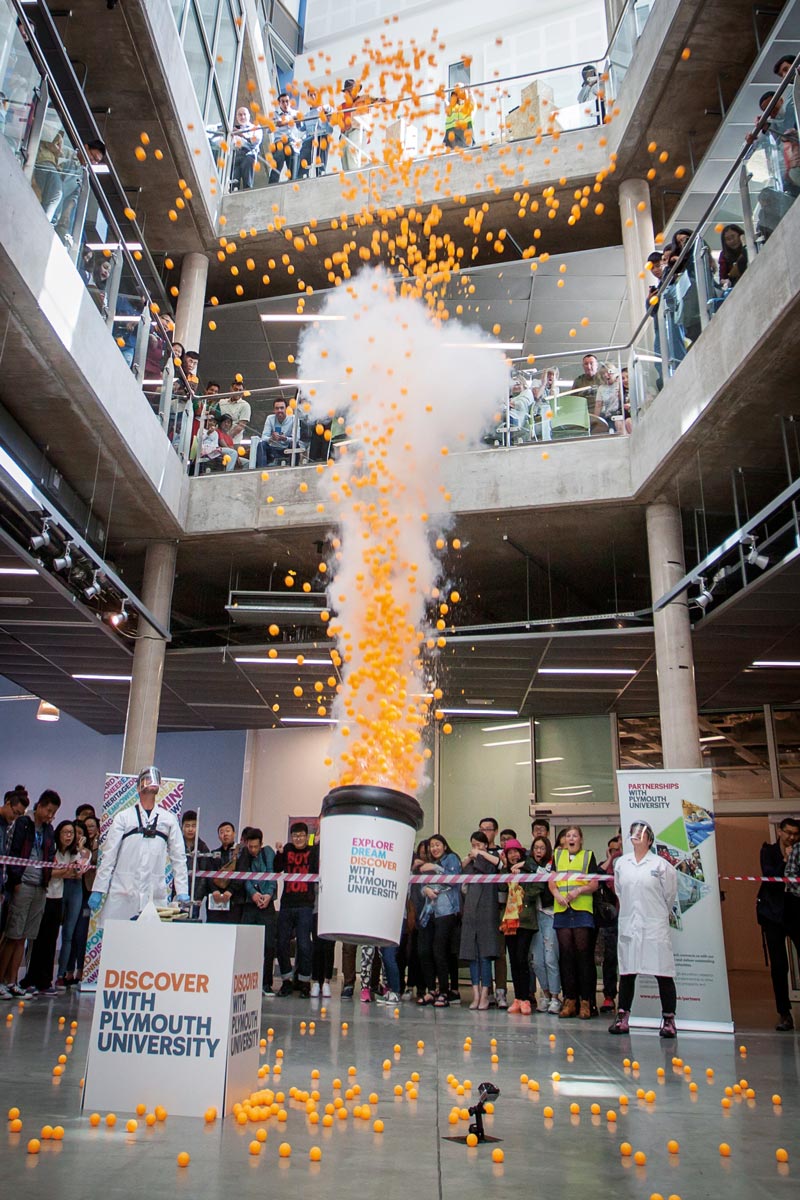
Plymouth University
In 2015, chemist Roy Lowry (left) reproduced the cannon at the University of PlymouthPlymouth UniversityFor a number of years videos have been circulating the internet showing an intriguing experiment, which has now received a satisfactory physical explanation. In the video, a plastic bottle with a bit of liquid nitrogen transforms a barrel full of ping-pong balls into a flashy cannon. While a liquid at temperatures below -196.15 degrees Celsius, nitrogen quickly turns to gas at room temperature, undergoing an explosive expansion that shoots thousands of balls into the air. The experiment has already been done on TV shows, and briefly created a scene in a campus building at Plymouth University in England, when chemist Roy Lowry performed it in 2015. The curious thing is that at the moment of the explosion, it’s not only the balls that go flying. The barrel also comes off the ground, sometimes rising as high as one meter, when what was expected was that it would remain stationary or ricochet.
The apparently simple experiment has been given an explanation from Brazilian and German researchers. In an article published in April in the American Journal of Physics, physicists Jason Gallas, from Rio Grande do Sul and Eric Parteli, from Pernambuco, with Santa Catarina engineer Daniel Nasato, in partnership with Germans Thorsten Pöschel and Patric Müller, showed that it is the friction between the balls themselves and between the balls and the barrel that makes the barrel fly.
Various attempts at an explanation had already come up on internet discussion forums. Some suggested that the explosion was causing the bottom of the barrel to deform and press into the ground, which in turn would push the barrel upwards. Others proposed that the group of balls, when ejected, formed a partial vacuum that was dragging the barrel upwards. The third explanation was more complicated. The nitrogen bottle was placed floating in water. The blast was throwing the balls up while pressing the water against the bottom and walls of the tub. As it retreated, the water would then pull the barrel up, making it jump.
These interpretations would explain the barrel’s rise under certain conditions, but, according to the researchers, were not relevant to the phenomenon observed. The barrel took off even when it was made of metal and had a rigid bottom. The group also saw no reason the explosion would create a vacuum, since the displaced air is quickly filled with nitrogen. If the vacuum were relevant, the barrel would still come off the ground even without the balls present, which was not the case. The third explanation, to be valid, would require that the barrel be slightly off the ground initially or that the floor be of an elastic material, whereas in many experiments the barrel is on a hard, dry floor. “We were looking for a general explanation,” says Nasato, now a researcher at the Technical University of Munich, Germany.
The group started thinking about it in 2011, when Gallas first saw the video. He arrived at the University of Erlangen-Nuremberg, Germany, for a term as a visiting professor and brought the subject to an informal discussion of physics subjects, the “kaffee seminar.” Thorsten Pöschel, director of the university’s Institute for Multiscale Simulation, found the problem interesting. Like Gallas, he specializes in the behavior of granular materials (grains of sand, food, and ores) and suspected that the barrel would bounce as a result of a known effect in his field: clogging.


